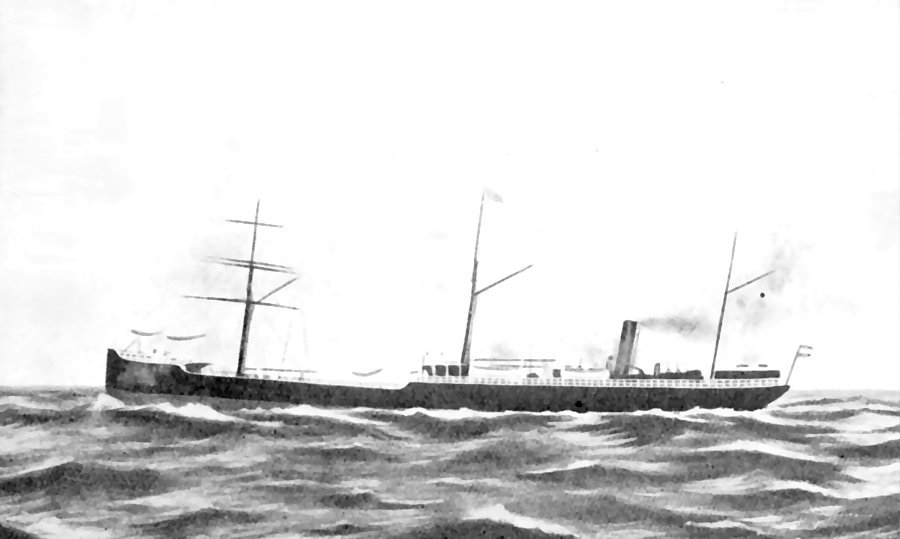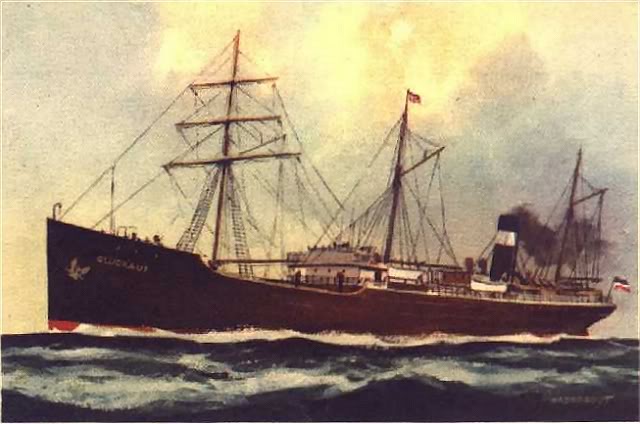Auke Visser´s German Esso Tanker's site | home
Gluckauf - (1886-1893)
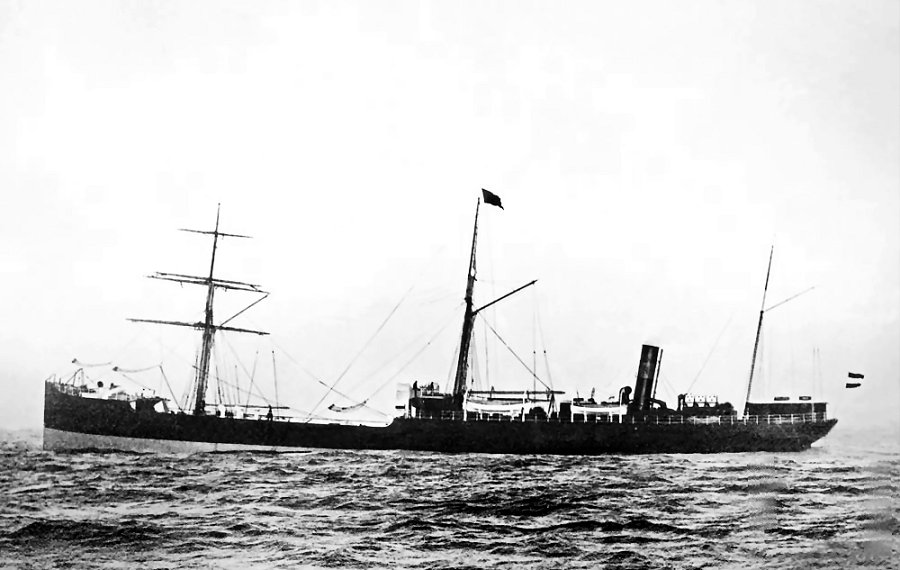
The world's first steam-powered oil tanker, the German-commissioned "Gluckauf", made its maiden voyage in 1886.
After tank shipowner Wilhelm Anton Riedemann, converted its sailing vessel "Andromeda", at the yard in Tecklenborg
Geestemünde, to an oil tanker, he found no shipyard in Germany which could built an oil tanker with a steam engine
as a newbuilding to create his plans for the future.
The first shipyard, which could do this was Armstrong & Mitchell in Low Walker, Newcastle on Tyne, UK. They built
the "Glückauf" in 1886 under yardnummer 473 for Riedemann's Company, Waried Tank Shipping Company.
After the first trip in New York, dock workers thought that their jobs were in danger. The "Glückauf" was for its owner
a great success. The following numerous new buildings, on the same principle like the "Glückauf", was the reason,
that the price of petroleum in Europe fell by half.
Tankdampfer GLÜCKAUF - KRBH
2318 BRT / 3000 tdw / 14 Ladetanks - 91,40 x 10,60 x 9,36 mtr.
1 Dreifach-Expansionsmaschine mit 1000 PSi, gebaut von der Werft, 10,5 Knoten
16.6.1886 Stapellauf.
10.7.1886 von Sir W. G. Armstrong, Mitchell & Co., Low Walker on Tyne, als GLÜCKAUF an Wilhelm A. Riedemann und Albt. Nie. Schütte & Sohn, Geestemünde (je 50 %), Mgr. Wilhelm A. Riedemann, abgeliefert und am 30.8.1886 registriert.
Die GLÜCKAUF ist der erste maschinengetriebene Einhüllentanker für die Hochseefahrt.
Am 13. Juli 1893 verläßt der Dampfer den Tyne nach New York, wo eine Ladung Petroleum für Geestemünde übernommen werden soll. Der Empfang ist jedoch keineswegs herzlich. Sowohl die Ladearbeiter wie auch die Hersteller von Fässern fürchten um ihre Existenz, wenn der Transport von losem 01 in Tanks sich durchsetzt. Die GLUCKAUF erhält zudem Polizeischutz, da man von der Brooklyn-Brücke aus Bomben auf das Schiff zu werfen droht. Zudem verweigern die New Yorker Kohlenhändler der GLÜCKAUF die Bunkerkohle. Alle Boykottmaßnahmen können die Entwicklung nicht aufhalten.
Am 17.4.1890 auf die am 25.2.1890 gegründeten Deutsch-Amerikanische Petroleum-Gesellschaft, Bremen, übertragen.
Am 23./24.3.1893 nähert sich die GLÜCKAUF in dichtem Nebel, von Swinemünde kommend, der nordamerikanischen Küste. Schon am Vortag konnte das Schiff nur mit kleiner Fahrt laufen. Über den genauen Schiffsort bestand Unklarheit, und der mittags an Bord gekommene Lotse trat seinen Dienst wegen des schlechten Wetters nicht an. Gerade, als eine Lotung vorgenommen werden sollte, strandete das Schiff, wie sich später herausstellte, bei Blue Point Beach auf Fire Island/Long Island. Da die Ballasttanks unglücklicherweise schon gelenzt waren, um im Hafen gleich mit dem Beladen beginnen zu können, gab es keine Möglichkeit, das Schiff zu leichtern. Alle Bergungsversuche schlugen fehl, die GLÜCKAUF mußte aufgegeben werden.
Das Wrack war noch viele Jahre zu sehen. Als Ursache wurde die Ungenauigkeit des Bestecks, eine zu hohe Geschwindigkeit und das Unterlassen des Lötens von Seiten der Schiffsführung festgestellt.
|
Tank Steamer GLÜCKAUF - KRBH
2318 GRT / 3000 DWT / 14 tanks - 91.40 x 10,60 x 9,36 mtr.
1 triple expansion engine by 1000 PSi, built by the shipyard, 10.5 knots
16/6/1886 launching.
10.7.1886 by Sir William G. Armstrong, Mitchell & Co., Low Walker on Tyne as GLÜCKAUF for Wilhelm A. Riedemann and Albt. Nie Schutte & Son, Geestemünde (50%), Mgr Wilhelm A. Riedemann, delivered and registered on 30.8.1886.
The GLÜCKAUF is the first engine-hull tankers for the open sea.
On 13 July 1893, the steamer leaves the Tyne to New York, where a cargo of kerosene for Geestemünde will be accepted. Reception but by no means cordial. Both the loader and also manufacturers of barrels, fear for their livelihoods, when the transport of bulk, 01 in tanks prevails.
The GLUCKAUF also receives police protection, since it threatens to throw off the Brooklyn Bridge from bombs on the ship. In addition, deny the New York coal merchant GLÜCKAUF of the bunkerscoal. All boycotts will not stop the development.
On 17.4.1890 to 25.2.1890 based on the German-American Petroleum Company, Bremen, transferred.
On approaching the 23./24.3.1893 GLÜCKAUF coming in thick fog, from Swinoujscie, the North American coast. The day before the ship could only sial with a small speed. About the precise ship's position was unclear, at the afternoon the pilot has come on board but took up his duties because of bad weather not. Just as a sounding should be carried out, the ship was stranded, as it turned out, at Blue Point Beach on Fire Iceland / Long Iceland. As the ballast tanks were already pumped out, unfortunately, to be able to start at the port with the loading, there was no way to lighten the ship. All rescue attempts failed, the GLÜCKAUF had to be abandoned.
The wreck could be seen for many years. The cause of the inaccuracy of the navigation, a too high speed and the failure of soldering on the part of the ship's command was found.
|
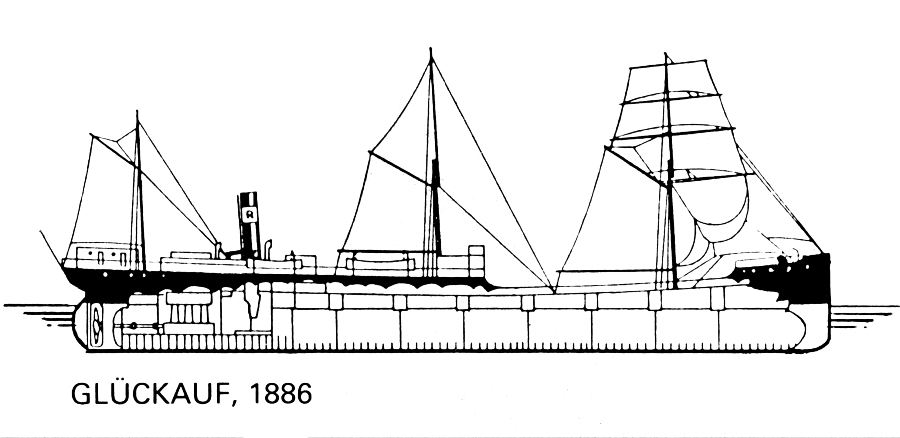
"Gluckauf".
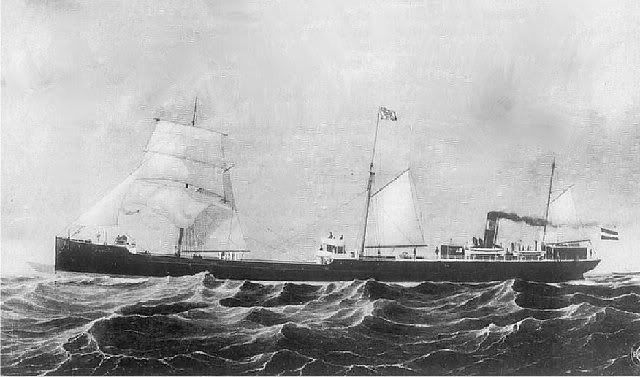
"Gluckauf".
Painting "Gluckauf" by Dutch Maritime painter G.J. Frans Naerebout.
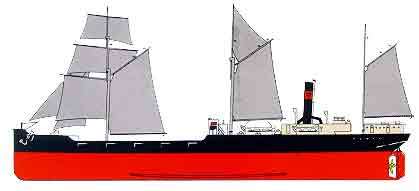
"Gluckauf".
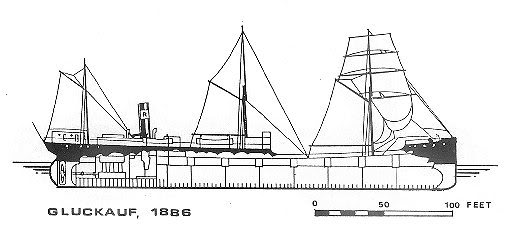
"Gluckauf".
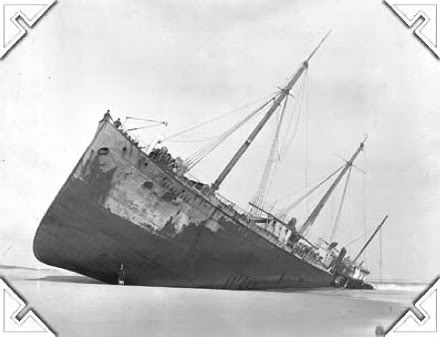
The doomed "Gluckauf" ----- Benjamin T West Photo - Long Island Maritime Museum.
Steamtanker "GLUCKAUF", KRBH
2318 BRT - 91,40 x 10,60 x 9,36 mtr.
1 Triple Expansion steam engine, 1000 PSi, build by Sir W. G. Armstrong, Mitchell & Co., Low Walker.
10,5 Knots, ? Crew. In July 1886 launch.
In August 1887 from Sir W. G. Armstrong, Mitchell & Co., Low Walker as "GLUCKAUF" to Wilhelm A. Riedemann and
Albt. Nic. Schütte & Sohn (each 50 %), Geestermünde, delivered and on 30.8.1986 registered.
17.04.1890 handed over to the Deutsch-Amerikanische Petroleum-Gesellschaft.
On 23./24.3.1893 stranded in heavy fog at Bleu Point Beach at Fire Island.
All salvage affords, failed.
The wreck could be seen for many years.
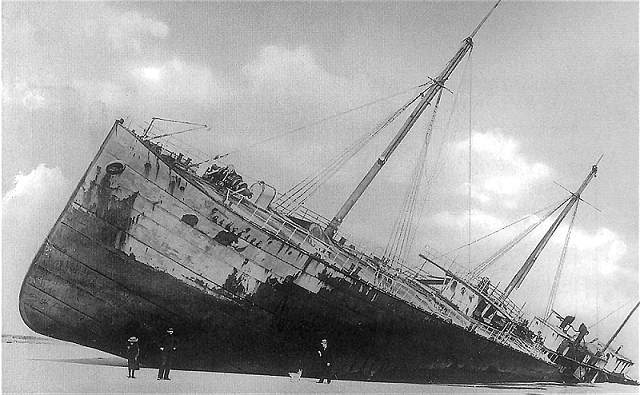
"Gluckauf".
